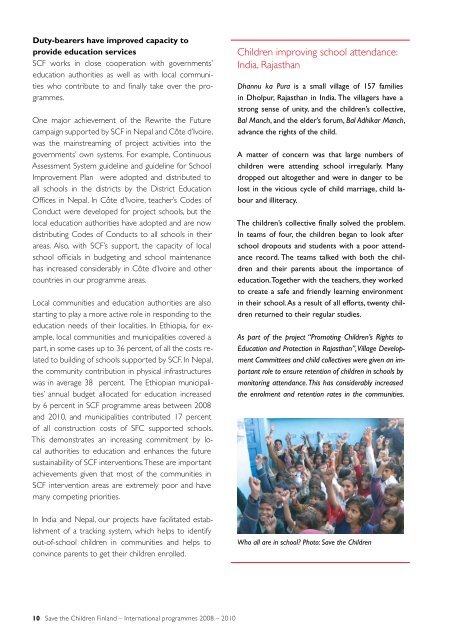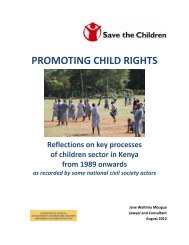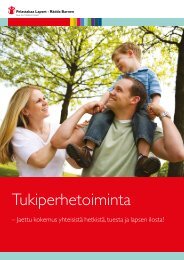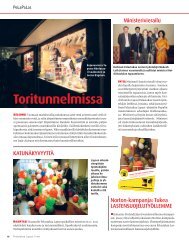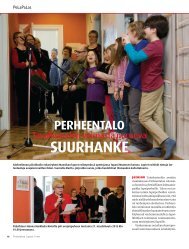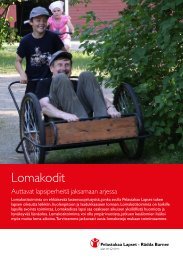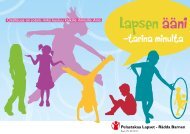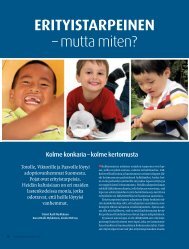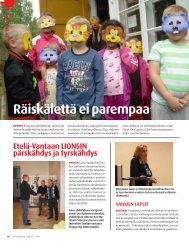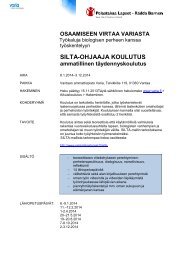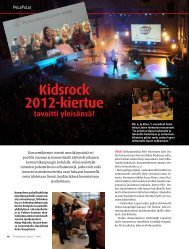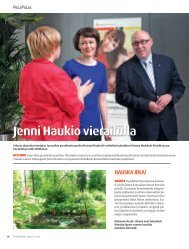Save the Children Finland International Programmes 2008 â 2010
Save the Children Finland International Programmes 2008 â 2010
Save the Children Finland International Programmes 2008 â 2010
You also want an ePaper? Increase the reach of your titles
YUMPU automatically turns print PDFs into web optimized ePapers that Google loves.
Duty-bearers have improved capacity to<br />
provide education services<br />
SCF works in close cooperation with governments’<br />
education authorities as well as with local communities<br />
who contribute to and finally take over <strong>the</strong> programmes.<br />
One major achievement of <strong>the</strong> Rewrite <strong>the</strong> Future<br />
campaign supported by SCF in Nepal and Côte d’Ivoire,<br />
was <strong>the</strong> mainstreaming of project activities into <strong>the</strong><br />
governments’ own systems. For example, Continuous<br />
Assessment System guideline and guideline for School<br />
Improvement Plan were adopted and distributed to<br />
all schools in <strong>the</strong> districts by <strong>the</strong> District Education<br />
Offices in Nepal. In Côte d’Ivoire, teacher’s Codes of<br />
Conduct were developed for project schools, but <strong>the</strong><br />
local education authorities have adopted and are now<br />
distributing Codes of Conducts to all schools in <strong>the</strong>ir<br />
areas. Also, with SCF’s support, <strong>the</strong> capacity of local<br />
school officials in budgeting and school maintenance<br />
has increased considerably in Côte d’Ivoire and o<strong>the</strong>r<br />
countries in our programme areas.<br />
Local communities and education authorities are also<br />
starting to play a more active role in responding to <strong>the</strong><br />
education needs of <strong>the</strong>ir localities. In Ethiopia, for example,<br />
local communities and municipalities covered a<br />
part, in some cases up to 36 percent, of all <strong>the</strong> costs related<br />
to building of schools supported by SCF. In Nepal,<br />
<strong>the</strong> community contribution in physical infrastructures<br />
was in average 38 percent. The Ethiopian municipalities’<br />
annual budget allocated for education increased<br />
by 6 percent in SCF programme areas between <strong>2008</strong><br />
and <strong>2010</strong>, and municipalities contributed 17 percent<br />
of all construction costs of SFC supported schools.<br />
This demonstrates an increasing commitment by local<br />
authorities to education and enhances <strong>the</strong> future<br />
sustainability of SCF interventions. These are important<br />
achievements given that most of <strong>the</strong> communities in<br />
SCF intervention areas are extremely poor and have<br />
many competing priorities.<br />
In India and Nepal, our projects have facilitated establishment<br />
of a tracking system, which helps to identify<br />
out-of-school children in communities and helps to<br />
convince parents to get <strong>the</strong>ir children enrolled.<br />
<strong>Children</strong> improving school attendance:<br />
India, Rajasthan<br />
Dhannu ka Pura is a small village of 157 families<br />
in Dholpur, Rajasthan in India. The villagers have a<br />
strong sense of unity, and <strong>the</strong> children’s collective,<br />
Bal Manch, and <strong>the</strong> elder’s forum, Bal Adhikar Manch,<br />
advance <strong>the</strong> rights of <strong>the</strong> child.<br />
A matter of concern was that large numbers of<br />
children were attending school irregularly. Many<br />
dropped out altoge<strong>the</strong>r and were in danger to be<br />
lost in <strong>the</strong> vicious cycle of child marriage, child labour<br />
and illiteracy.<br />
The children’s collective finally solved <strong>the</strong> problem.<br />
In teams of four, <strong>the</strong> children began to look after<br />
school dropouts and students with a poor attendance<br />
record. The teams talked with both <strong>the</strong> children<br />
and <strong>the</strong>ir parents about <strong>the</strong> importance of<br />
education. Toge<strong>the</strong>r with <strong>the</strong> teachers, <strong>the</strong>y worked<br />
to create a safe and friendly learning environment<br />
in <strong>the</strong>ir school. As a result of all efforts, twenty children<br />
returned to <strong>the</strong>ir regular studies.<br />
As part of <strong>the</strong> project “Promoting <strong>Children</strong>’s Rights to<br />
Education and Protection in Rajasthan”, Village Development<br />
Committees and child collectives were given an important<br />
role to ensure retention of children in schools by<br />
monitoring attendance. This has considerably increased<br />
<strong>the</strong> enrolment and retention rates in <strong>the</strong> communities.<br />
Who all are in school Photo: <strong>Save</strong> <strong>the</strong> <strong>Children</strong><br />
10 <strong>Save</strong> <strong>the</strong> <strong>Children</strong> <strong>Finland</strong> – <strong>International</strong> programmes <strong>2008</strong> – <strong>2010</strong>


